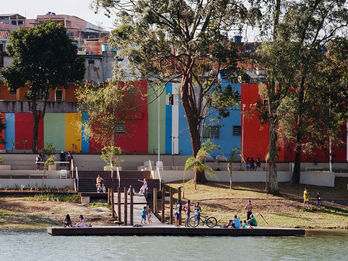2014 Emerge Prize

Cantinho do Céu Complex
Marcos Boldarini
São Paulo, Brazil
December 2011
AUTOR PRINCIPAL
Boldarini Arquitetos Associados
AUTOR CONTRIBUYENTE
Melissa Matsunaga - Boldarini Arquitetos Associados (Arquitect), Cristiana Salomão - Boldarini Arquitetos Associados (Arquitect), Josiane Viana Boldarini Arquitetos Associados (Arquitect), Juliana J. Pedroso de Melo - Boldarini Arquitetos Associdos (Arquitect), Larissa Reolon dos Santos - Boldarini Arquitetos Associados (Arquitect), Lucas Nobre - Boldarini Arquitetos Associados (Partner), Melina Giannoni - Boldarini Arquitetos Associados (Arquitect), Renato Bomfim - Boldarini Arquitetos Associados (Arquitect), Ricardo Falcoski - Boldarini Arquitetos Associados (Arquitect), Sergio Faraulo - Boldarini Arquitetos Associados (Arquitect), Simone Ikeda - Boldarini Arquitetos Associadso (Arquitect)
CLIENTE
Ricardo Corrêa Sampaio - Programa Mananciais Coordinator
FOTÓGRAFO
Daniel Ducci, Fabio Knoll, Marcelo Rebelo
OBJETIVO
Access and mobility improvement, environmental sanitation infrastructure allocation to Cantinho do Céu Complex resident population, as well as the reversing the negative environmental impact represented by the absence of infrastructures for the Billings fountainhead and the quality of water supply to part of São Paulo's metropolitan region population were basis for the intervention by guaranteeing minimum urbanity standards. Once such idea has been consolidated, another goal was to enhance the public space, which was seen in this case as the set of elements able to support many different everyday collective events – streets, alleys, squares, parks – aimed at rescuing the feeling of belonging to the city as basic condition for the development of future generations. Therefore, intervention in Cantinho do Céu Complex was worked on by understanding this settlement qualification importance sue to their scale and location in an environmentally strategic area for the city of São Paulo. The Park brought some green and leisure to life amid the dense occupation, seeking to bring the population closer to water in areas that would be subject to removal due to impossibility of connection to sewerage systems or hazardous situations. The definition of various areas with specific uses to the population of all age groups has been sought so they could find a location for their leisure in the range between the private area occupied and the reservoir, by associating recreation uses for the preservation of the margin with the maintenance and restoration of native plant species.
CONTEXTO
Intervening in a precarious settlement means recognizing their territorial pre-existences, potential and limitations. Therefore, in addition to site-specific issues, designing in such context means considering local residents' integration and mobility possibilities with the rest of the metropolis. The South Zone of the city of São Paulo, where Cantinho do Céu Complex is located, has undergone an intense transformation process over the last few decades. The local landscape, once characterized by fountainhead areas, has significantly changed, and is now characterized, with rare exceptions, by irregular occupations with high density rates, absence of public spaces and equipment as well as lack of urban infrastructure. Within such context, developed from studies and guidelines formulated by the Municipal Secretariat of Housing in conjunction with the District Attorney's Office, a urbanization project for informal settlements and occupations that make up the Cantinho do Céu Complex has been developed as an alternative to a public civil action which stipulated the evacuation of the area. Faced with the challenge of intervening in this consolidated, densely occupied, environmentally fragile area, with geotechnical risk and large territorial limits and with direct access to the Billings reservoir, apart from aggravating the lack of basic sanitation, new project trials were required. Chances of intervention that aimed to supply their infrastructure deficits, qualify and integrate them into town and reveal the importance of collective and public space for the local population would be indispensable.
ACTUACIÓN
Cantinho do Céu Complex population, which is used to living in the economy, urban, and cultural outskirts of the metropolis of São Paulo, has now access to environmental sanitation services, such as sewage treatment, water supply, garbage collection, which was incipient before that. In addition, access roads improvement and streets paving allowed for better accessibility of both pedestrians and cars as well as public transport. The constant use of the park for the most diverse leisure, sport and recreation activities can be seen on any given day. Dam water contact resumption and free spaces creation in the neighborhood represent an unimaginable life quality gain for its residents. The Park provided the population for a leisure pent up demand. The nearly 40,000 Complex inhabitant gets to be 300 inhabitants by hectare in certain parts, with no public leisure options before. The approximately 1.3 km long linear park ready stretch represents a coexistence and exchange space, in addition to the resident's pride feeling while hosting their relatives and friends in a decent and structured neighborhood, with well-defined public areas, football court, third age gym, skate park, playground, hiking trail and several free areas - result of a careful space and occupation remaining area selection for the design practice.











